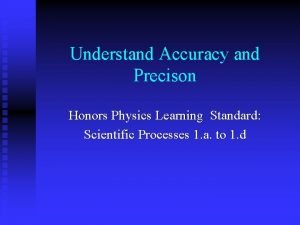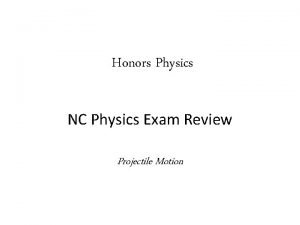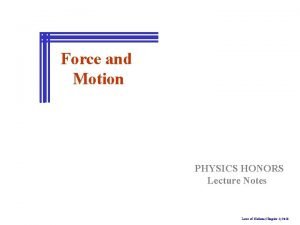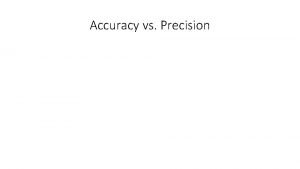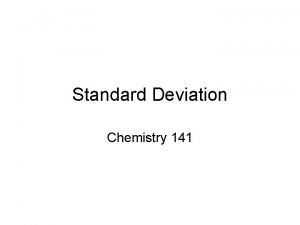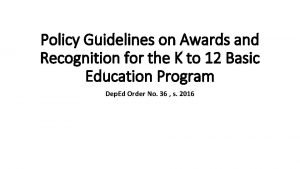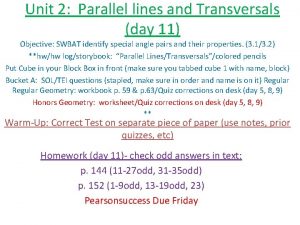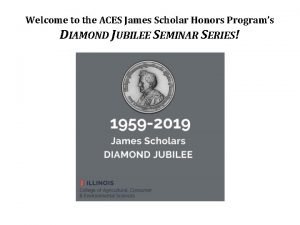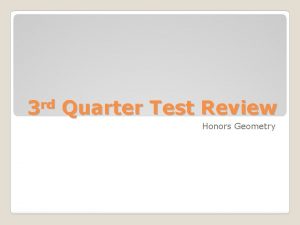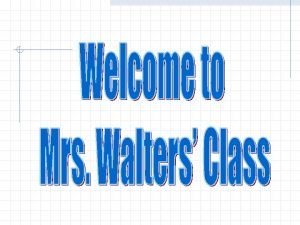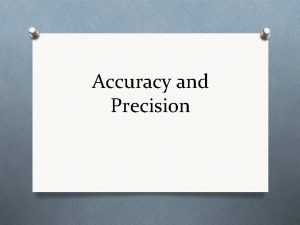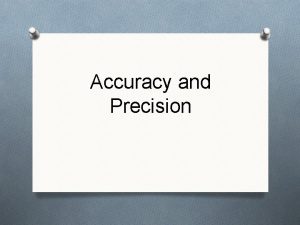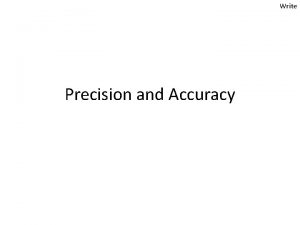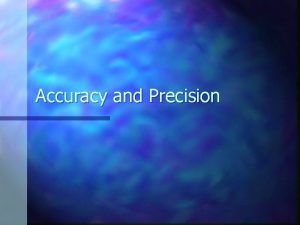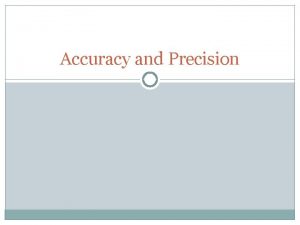Understand Accuracy and Precison Honors Physics Learning Standard


















- Slides: 18

Understand Accuracy and Precison Honors Physics Learning Standard: Scientific Processes 1. a. to 1. d

Accuracy and Precision Much of science has to do with the collection and manipulation of quantitative or numerical data. n The value of computations using numerical data is greatly dependent on the accuracy and precision of that data. n

Exact Numbers l l Discrete Data Obtained when you count objects 2 soccer balls 60 BB’s 1 watch 4 pizzas Obtained from a defined relationship 1 foot = 12 inches 1 meters = 100 cm Not obtained with measuring tools We will later learn that these numbers do not limit the number of significant figures reported.

Measured Numbers When you use a measuring tool to determine a quantity such • Your height • Volume of a liquid • Time to run a mile the numbers you obtain are called measured numbers.

Accuracy Example: Liquid Volume

What is the smallest unit you can measure from each of these Graduated Cylinders? . 2 m. L 0 s i k mar Each art so it is L. ap 0. 2 m o t d ate calibr Each m ark is apart so 1 m. L it is calibrat ed to 1 m. L.

What is the correct reading for each one? 20. 60 m. L 22. 5 m. L

What is the correct reading for each one? 20. 60 m. L 22. 5 m. L Since the calibration of the GC on the left is finer, the reading from the GC on the left has more significant digits to show sure you can be about your measurement.

Accuracy and Precision n There is always some degree of ERROR in a measurement. This is due to: u Precision of the Equipment u Accuracy of the Measurement 20. 60 m. L 22. 5 m. L

ACCURACY n Accuracy is how close a number is to what it should be. u determined by comparing a number to a known or accepted value.

PRECISION Precision is how close repeated (successive) measurements are to each other. u It is sometimes defined as reproducibility n Precision is shown by the number of decimal places assigned to the measured number. u The precision of a value determines the number of significant figures. n

Both Accuracy and Precision depend • on the calibration and the quality of the measuring tool. • On the competence of the scientist taking the measurement.

Accuracy and Precision Accuracy and precision can not be considered independently n A measurements can be accurate and not precise n A measurements can be precise and not accurate n

Example 1: n n Calibration: Years How old are you? u I am 16 years old u I am 15 years, 8 months old Calibration: Hours u I am 15 years, 8 months, 5 days old u I am 15 years, 8 months, 5 days, 10 hours old Each of these statements is more accurate and more precise than the one before it.

Example 2: n n How long is a piece of string? u Johnny measures the string at 2. 63 cm. u Using the same ruler, Fred measures the string at 2. 899 cm. u Who is most precise? u Who is most accurate? The actual measurement is 2. 65 cm. n n Johnny is fairly accurate and also very precise. Fred is very precise, however, he is not very accurate. His lack of accuracy is due to using the ruler incorrectly.

Example 3 n n Using a centigram balance, u Mary measured a sample at 3 g. u Ashley measured the sample at 3. 00 g. u Who is most precise? u Who is most accurate? The actual measurement is 3. 01 g. n n Mary is reasonably accurate. She was not very precise because the balance was capable of measuring to two decimal places. Ashley is much more accurate because of the precision of her measurement and closeness of her value to the actual value.

ACCURACY/PRECISION n n n You can tell the precision of a single measurement simply by looking at it. The number of decimal places gives the precision of the reading. The precision of a group of readings depends on how close the readings are to one another. Accuracy on the other hand, depends on comparing a number to a known value. Therefore, you cannot simply look at a number and tell if it is accurate

In Conclusion In science we depend upon both the accuracy and precision of the numbers we use. n It is vital to recognize that the number of digits communicates accuracy and precision. n
 Accuracy vs precison
Accuracy vs precison To understand recursion you must understand recursion
To understand recursion you must understand recursion Honors physics semester 1 review
Honors physics semester 1 review Honors physics projectile motion test
Honors physics projectile motion test Physics honors notes
Physics honors notes Accuracy vs. precision
Accuracy vs. precision Standard deviation and precision
Standard deviation and precision Cuadro comparativo de e-learning
Cuadro comparativo de e-learning Deped order no. 36 s. 2016
Deped order no. 36 s. 2016 Ucsb urca
Ucsb urca Honors geometry parallel lines and transversals worksheet
Honors geometry parallel lines and transversals worksheet Creighton honors program
Creighton honors program Aces james scholar
Aces james scholar Honors biology ecology test
Honors biology ecology test Economics 4.05 uncle sam's toolbox honors
Economics 4.05 uncle sam's toolbox honors Quadrilateral test review
Quadrilateral test review Honors earth science
Honors earth science Kuei honors chemistry
Kuei honors chemistry Honors math 3
Honors math 3
